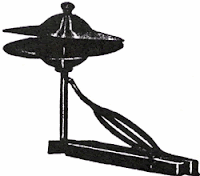Before I go into culture/genres and drum set use, I feel like I need to talk about one more ingenious invention related to this instrument. This invention came about in the 1920’s and was called the low boy, which was the predecessor to the hi-hat. This useful and cool-looking instrument stood about 12 inches high, and had two cymbals that would close together when played with the foot.
Before the invention of the low boy, drummers would accent beats 2 and 4 by choking a cymbal with their hands…that seems like a lot of work! Once these accented beats could be played with the foot, the hands were freed up to syncopate rhythms to a greater degree.
The low boy was elevated twice in its history – first to 20 inches high, and this became known as the sock cymbal. Later it got elevated even higher and became known as the hi-hat, which is the incarnation that is still used with contemporary drummers. The hi-hat came about because drummers wanted the option of playing these cymbals with drumsticks, and not just their foot.
Stop by the Earthtone School of Music website to take drum lessons and learn how to play that hi-hat! www.earthtoneschoolofmusic.com/drumlessons.html
By Tim Kurteff-Schatz
